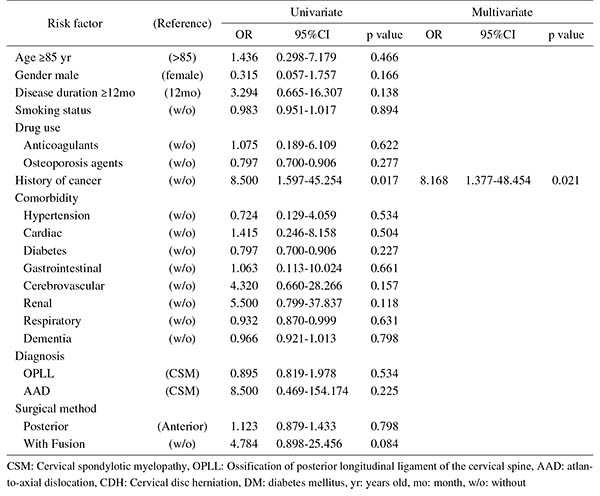- 著者
- Koji Tamai Hidetomi Terai Akinobu Suzuki Hiroaki Nakamura Masaomi Yamashita Yawara Eguchi Shiro Imagama Kei Ando Kazuyoshi Kobayashi Morio Matsumoto Ken Ishii Tomohiro Hikata Shoji Seki Masaaki Aramomi Tetsuhiro Ishikawa Atsushi Kimura Hirokazu Inoue Gen Inoue Masayuki Miyagi Wataru Saito Kei Yamada Michio Hongo Kenji Endo Hidekazu Suzuki Atsushi Nakano Kazuyuki Watanabe Junichi Ohya Hirotaka Chikuda Yasuchika Aoki Masayuki Shimizu Toshimasa Futatsugi Keijiro Mukaiyama Masaichi Hasegawa Katsuhito Kiyasu Haku Iizuka Kotaro Nishida Kenichiro Kakutani Hideaki Nakajima Hideki Murakami Satoru Demura Satoshi Kato Katsuhito Yoshioka Takashi Namikawa Kei Watanabe Kazuyoshi Nakanishi Yukihiro Nakagawa Mitsunori Yoshimoto Hiroyasu Fujiwara Norihiro Nishida Masataka Sakane Masashi Yamazaki Takashi Kaito Takeo Furuya Sumihisa Orita Seiji Ohtori
- 出版者
- The Japanese Society for Spine Surgery and Related Research
- 雑誌
- Spine Surgery and Related Research (ISSN:2432261X)
- 巻号頁・発行日
- vol.1, no.4, pp.179-184, 2017-10-20 (Released:2017-11-27)
- 参考文献数
- 26
- 被引用文献数
- 3 3
Introduction: With an aging population, the proportion of patients aged ≥80 years requiring cervical surgery is increasing. Surgeons are concerned with the high incidence of complications in this population, because "age" itself has been reported as a strong risk factor for complications. However, it is still unknown which factors represent higher risk among these elderly patients. Therefore, this study was conducted to identify the risk factors related to surgical complications specific to elderly patients by analyzing the registry data of patients aged ≥80 years who underwent cervical surgery.Methods: We retrospectively studied multicenter collected registry data using multivariate analysis. Sixty-six patients aged ≥80 years who underwent cervical surgery and were followed up for more than one year were included in this study. Preoperative patient demographic data, including comorbidities and postoperative complications, were collected from multicenter registry data. Complications were considered as major if they required invasive intervention, caused prolonged morbidity, or resulted in prolongation of hospital stay. Logistic regression analysis was performed to analyze the risk factors for complications. A p-value of <0.05 was considered as statistically significant.Results: The total number of patients with complications was 21 (31.8%), with seven major (10.6%) and 14 minor (21.2%) complications. Multivariate logistic regression analysis, after adjusting for age, revealed two significant risk factors: preoperative cerebrovascular disorders (OR, 6.337; p=0.043) for overall complications and cancer history (OR, 8.168; p=0.021) for major complications. Age, presence of diabetes mellitus, and diagnosis were not significant predictive factors for complications in this study.Conclusions: Preoperative cerebrovascular disorders and cancer history were risk factors for complications after cervical surgery in patients over 80 years old. Surgeons should pay attention to these specific risk factors before performing cervical surgery in elderly patients.
- 著者
- Hiroaki Satoh Kanako Okazaki Tetsuya Ohira Akira Sakai Mitsuaki Hosoya Seiji Yasumura Yukihiko Kawasaki Koichi Hashimoto Akira Ohtsuru Atsushi Takahashi Kazuyuki Watanabe Michio Shimabukuro Junichiro James Kazama Shigeatsu Hashimoto Gen Kobashi Hiromasa Ohira Hitoshi Ohto Kenji Kamiya
- 出版者
- Japan Epidemiological Association
- 雑誌
- Journal of Epidemiology (ISSN:09175040)
- 巻号頁・発行日
- vol.32, no.6, pp.277-282, 2022-06-05 (Released:2022-06-05)
- 参考文献数
- 17
- 被引用文献数
- 3
Background: The Great East Japan Earthquake and the Fukushima Daiichi nuclear disaster forced the evacuation of residents and led to many changes in lifestyle for the evacuees. The Comprehensive Health Check was implemented to support the prevention of lifestyle-related disease and we analyzed the effect of prolonged evacuation (average of 3.0 years) on the new onset of hyper-LDL cholesterolemia.Methods: The study participants were Japanese adults living near the Fukushima Daiichi nuclear power plant in Fukushima Prefecture. Annual health checkups focusing on metabolic syndromes were conducted for persons ≥40 years by the Specific Health Checkup. Based on data from annual checkups from 2011 or 2012, we followed 18,670 participants without hyper-LDL cholesterolemia who underwent at least one other annual checkup during 2013–2015.Results: We found that the new onset of hyper-LDL cholesterolemia was 31% higher in evacuees than in non-evacuees. Evacuees had a significantly higher prevalence of obesity, hypertension, and diabetes, and higher frequency of weight change. Furthermore, logistic regression model analysis showed that the evacuation was significantly associated with the new onset of hyper-LDL cholesterolemia after adjusting age, gender, body mass index, smoking habit, alcohol consumption, diabetes, weight change, sleep deprivation, and exercise.Conclusion: The findings of the present study suggest that prolonged evacuation after a disaster is a risk factor for the new onset of hyper-LDL cholesterolemia, and lead to an increase in cardiovascular disease. It is therefore important to follow-up evacuees and recommend lifestyle changes where necessary.
